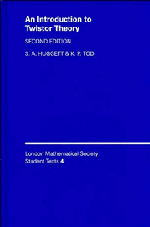Book contents
- Frontmatter
- Contents
- Preface
- Preface to the second edition
- 1 Introduction
- 2 Review of Tensor Algebra and Calculus
- 3 Lorentzian Spinors at a Point
- 4 Spinor Fields
- 5 Compactified Minkowski Space
- 6 The Geometry of Null Congruences
- 7 The Geometry of Twistor Space
- 8 Solving the Zero Rest Mass Equations I
- 9 Sheaf Cohomology and Free Fields
- 10 Solving the Zero Rest Mass Equations II
- 11 The Twisted Photon and Yang–Mills Constructions
- 12 The Non-Linear Graviton
- 13 Penrose's Quasi-Local Momentum and Angular Momentum
- 14 Functionals on Zero Rest Mass Fields
- 15 Further Developments and Conclusions
- 16 Hints, Solutions and Notes to the Exercises
- Appendix The GHP Equations
- Bibliography
- Index
13 - Penrose's Quasi-Local Momentum and Angular Momentum
Published online by Cambridge University Press: 25 January 2010
- Frontmatter
- Contents
- Preface
- Preface to the second edition
- 1 Introduction
- 2 Review of Tensor Algebra and Calculus
- 3 Lorentzian Spinors at a Point
- 4 Spinor Fields
- 5 Compactified Minkowski Space
- 6 The Geometry of Null Congruences
- 7 The Geometry of Twistor Space
- 8 Solving the Zero Rest Mass Equations I
- 9 Sheaf Cohomology and Free Fields
- 10 Solving the Zero Rest Mass Equations II
- 11 The Twisted Photon and Yang–Mills Constructions
- 12 The Non-Linear Graviton
- 13 Penrose's Quasi-Local Momentum and Angular Momentum
- 14 Functionals on Zero Rest Mass Fields
- 15 Further Developments and Conclusions
- 16 Hints, Solutions and Notes to the Exercises
- Appendix The GHP Equations
- Bibliography
- Index
Summary
In general relativity there is a long-standing problem of defining momentum and angular momentum in a general curved space-time. In this chapter, we describe an application of twistor theory which aims to provide a solution to this problem. As we shall see, this aim is not entirely achieved and the programme has both successes and failures.
We recall that in general relativity, all the local matter content is described by the stress–energy tensor Tab. Gravitational energy, whether in gravitational waves or in the form of gravitational potential energy, is notoriously non-local and one cannot expect to characterise it by a local density. Instead, Penrose (1982) has suggested that one should seek a non-local invariant associated to any two-surface S and representing the total momentum–angular momentum flux through that surface. This non-local invariant will be constructed by twistorial techniques tailored to give the right answer for linearised general relativity where there is a clear right answer.
We begin by reviewing the definition of momentum and angular momentum in special relativity and in linearised general relativity.
A material system in special relativity is defined by its stress–energy tensor Tab which we may suppose for definiteness to have support within a world tube W in Minkowski space, M. (The case of say electromagnetic fields spread throughout M is a simple generalisation.)
- Type
- Chapter
- Information
- An Introduction to Twistor Theory , pp. 119 - 136Publisher: Cambridge University PressPrint publication year: 1994



